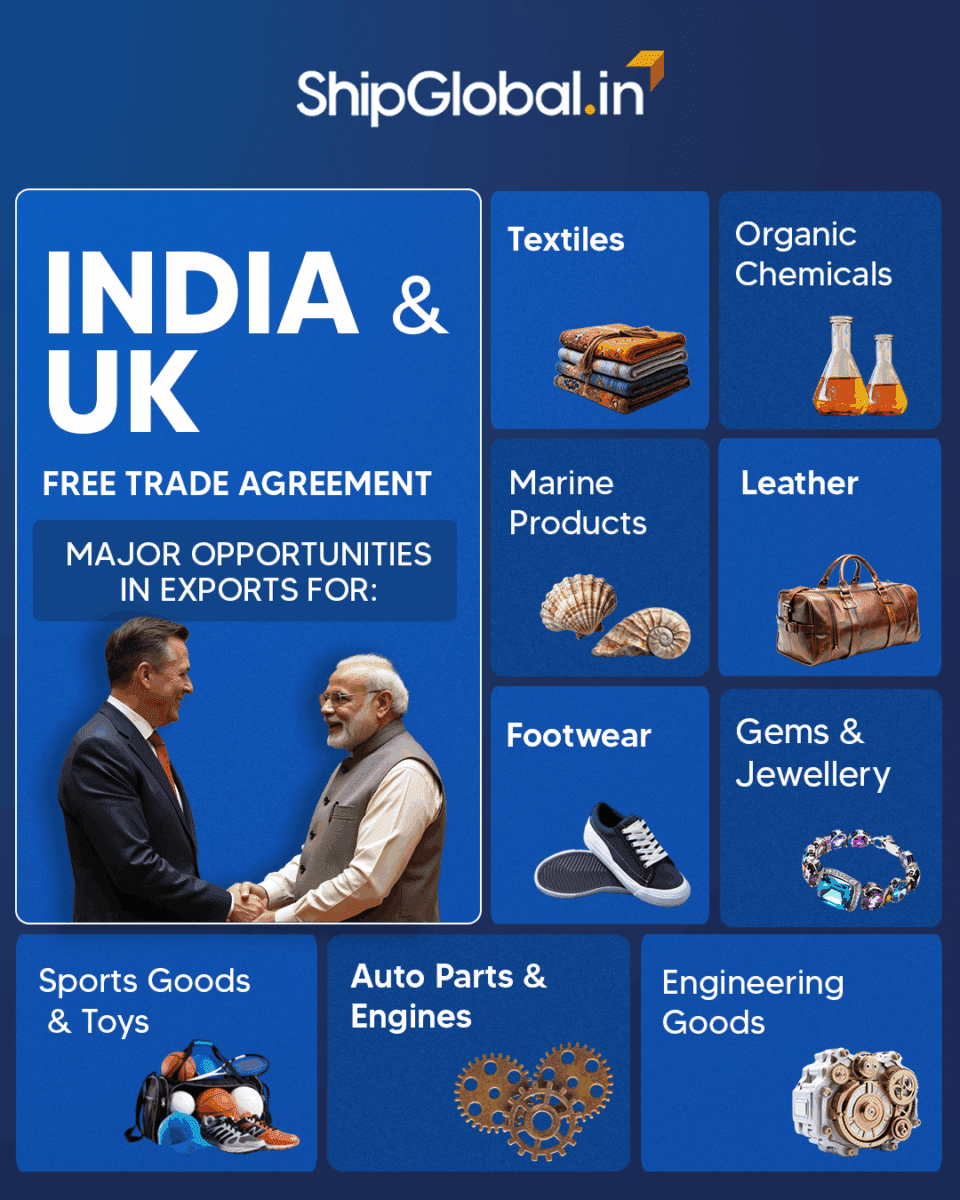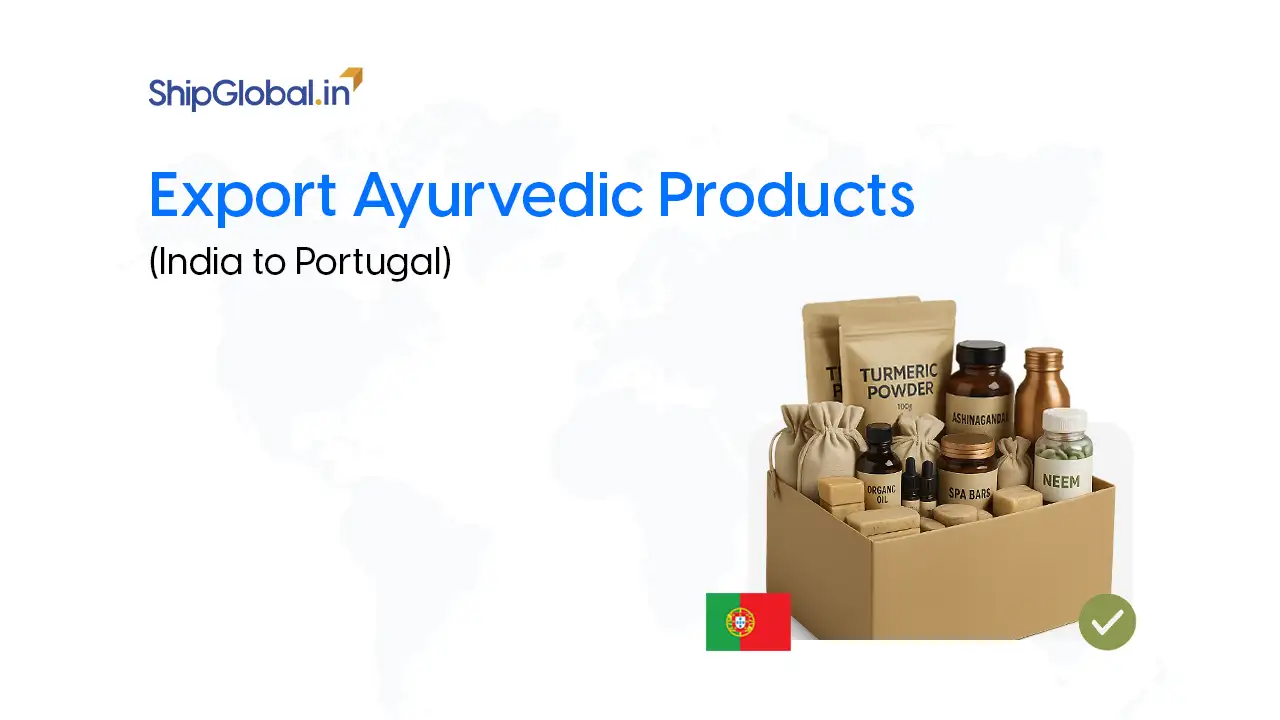India and the United Kingdom have finally signed a Free Trade Agreement – yes, after years of discussions, it’s official.
Now, you might be wondering, “Okay, but what does that really mean for me?”
Well, here’s the short answer: less cost, fewer restrictions, and more room to grow your business in the UK, one of the world’s biggest and most stable markets.
And here’s the best part, this isn’t just good news for big companies. Whether you’re a manufacturer in Surat, a textile exporter from Tiruppur, or running a growing D2C brand out of Jaipur, this India UK trade deal could directly benefit you.
Still curious? Great.
Let’s break it all down, simply, clearly, and with your business in mind.
What is a Free Trade Agreement
A Free Trade Agreement is a deal between two countries where they agree to reduce or remove taxes (called tariffs) on products and services they buy from each other. It also helps make rules simpler so that businesses can trade more easily.
This new India–UK Free Trade deal is one of the most important agreements India has signed in recent years. It’s not just about trade but trust, growth, and long-term partnership.
Commodities that will Benefit
One of the biggest benefits of this deal is tariff elimination. The UK has agreed to remove tariffs on 99% of Indian goods (by value). That means most Indian products going to the UK will no longer have to pay extra taxes at the border.
As a result, your products will become cheaper and more attractive in the UK market, helping you win more customers and make better profits.
The complete elimination of duties on a wide range of agri-products, processed foods, and industrial goods. This means Indian exporters across multiple sectors can now ship to the UK at zero duty, making their offerings significantly more competitive.

In the agri and food category, the UK will now allow animal products, vegetable and oil-based products, and processed foods into its market at zero tariffs. Previously, these categories faced duties as high as 20% to 70%, but now, over 99% of tariff lines in each of these segments will be duty-free under the agreement.
For industrial goods, the benefit is equally wide-ranging. Sectors that earlier faced import duties ranging from 4% to 18% — such as gems and jewellery, textiles, footwear, chemicals, machinery, transport equipment, clocks, furniture, and even works of art — will now enjoy zero-duty access to the UK market.
This not only lowers the cost for UK buyers but also puts Indian products at a clear advantage over competitors from non-FTA countries. It’s a powerful push for India’s export diversification and competitiveness, especially for MSMEs and high-potential manufacturing clusters.
This is especially good news if you export:
- Textiles and garments
- Leather and footwear
- Marine products
- Gems and jewellery
- Auto parts and engineering goods
- Organic chemicals
- Toys and sports goods
These are all labour-intensive and technology-driven sectors — and now, they’re ready to grow.
Bilateral Economic Cooperation: A Stronger Bond
This agreement also improves bilateral economic cooperation between India and the UK. That means both countries are working more closely, not just in trade, but also in investment, services, technology, and skills.
For Indian exporters, this creates more stability, better business relationships, and a strong long-term market to rely on.
Goods and Services Trade: Double the Opportunity
This deal isn’t just about physical goods. It also opens up services trade, which is a huge deal for India.
If you’re in IT, ITeS, finance, consulting, or education, you now have better access to clients and companies in the UK. The rules for offering your services there will be simpler, clearer, and fairer.
Mutual Recognition Agreements: Get Recognised Faster
Have you ever faced problems because your qualifications or product certifications from India weren’t accepted in the UK?
That’s where Mutual Recognition Agreements (MRAs) come in. These allow the UK to recognise Indian standards and qualifications, making it easier for you to start working or exporting your services faster.
No more delays, no more re-approvals.
Rules of Origin: More Flexibility for You
Here’s something many exporters worry about — what if your product has some parts made in another country?
Thanks to the new rules of origin, your product can still qualify as “Made in India” even if a few parts are imported, as long as the main value is added in India.
That means you can still enjoy the tariff benefits of the India-UK FTA, without changing your whole supply chain.
Zero Duty Imports: Lower Your Costs
Just like your exports to the UK will face no or low duties, you can now also import machinery, tools, or raw materials from the UK at lower costs.
This helps improve your product quality while keeping your input costs down.
So if you’ve been thinking about upgrading your manufacturing, now’s the time.
Market Diversification: Reduce Your Risk
Most Indian exporters still rely heavily on just a few markets, like the US, UAE, or Europe. But what happens when one of those markets slows down or changes its import policies?
That’s why market diversification is so important. With this India UK FTA, you now have easier, long-term access to the UK, a high-income, stable, and post-Brexit market that’s actively looking for strong trade partners.
The UK could become your next big market — and a stepping stone to the rest of Europe.
What Should Exporters Do Now
How exporters can take advantage of India UK FTA
- Check your product categories: Are they now tariff-free?
- Review your pricing: Can you offer better prices in the UK market?
- Build partnerships: Find UK buyers, distributors, or business partners.
- Understand the paperwork: Get clear on new documentation, rules of origin, and shipping terms.
- Promote your products: Use this new access as a selling point to stand out.
Final Thoughts
The India–UK Free Trade Agreement is not just a deal between two governments, it’s a door that opens to new customers, better prices, and real growth.
It offers benefits across all key areas — tariff elimination, goods and services trade, professional mobility, market diversification, and rules of origin. It’s designed to make trade simpler, smoother, and more profitable for Indian exporters across industries.
If you’re already exporting, this is your moment to scale up — reach more buyers, expand your product line, and improve your margins.
If you’re just getting started, this is your chance to start strong, with easier access to one of the world’s most stable and high-value markets.
The UK market is now more open, more accessible, and more welcoming to Indian products and services than ever before. And it’s not just about numbers — it’s about creating meaningful trade relationships that last.
So take the next step.
Explore the possibilities.
Get your business ready to go global — with confidence, with clarity, and with full advantage of the India–UK Free Trade Agreement.
Because the world is waiting.
And the UK is ready.
The question is — are you?
Frequently Asked Questions
It’s a trade deal that removes or reduces tariffs on most goods and services between India and the UK.
It makes your products more competitive in the UK by cutting import duties.
Textiles, auto parts, gems, chemicals, leather goods, IT, and financial services.
Yes, MSMEs can access the UK market more easily and save on costs.
Not necessarily — flexible rules of origin mean you can still qualify even if some parts are imported.









